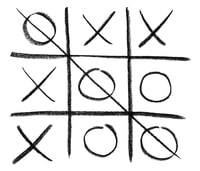Ultimate Guide to Knots and Crosses: Fun Strategies for Parents and Kids
Hello, wonderful parents! Get ready to dive into the delightful world of Knots and Crosses, also popularly known as Tic Tac Toe. Are you looking for a simple yet entertaining game to play with your little ones? Whether you’re at home on a rainy day or looking for a quick game to while away time at a restaurant, Knots and Crosses comes to the rescue!
In this comprehensive article, we’ll explore everything you need to know about this classic game. From its rich history to clever strategies that can turn the tide in your favor, we’ve got you covered. So, let’s get those game faces on and prepare for some cross and noughts fun!
Understanding the Basics of Knots and Crosses
Before we jump into strategies, let’s ensure we’re all on the same page with the basics. Knots and Crosses is a two-player game played on a 3×3 grid. One player uses crosses (X) and the other uses noughts or knots (O). The aim is to be the first to get three of your markers in a row—horizontally, vertically, or diagonally—while preventing your opponent from doing the same.
Why Knots and Crosses Is Perfect for Kids
Not only is Knots and Crosses a fun way to pass the time, but it’s also brimming with educational benefits for children. It helps to:
- Improve cognitive skills and strategic thinking
- Teach the concept of sportsmanship and healthy competition
- Boost problem-solving abilities
- Foster parental bonding in a light, playful setting
Setting Up the Game
Before we start with fancy footwork, we need to set up our dance floor. Here’s how to set up a game of Knots and Crosses:
- Grab a piece of paper and a pen or pencil.
- Draw two vertical lines intersecting with two horizontal lines to create a 3×3 grid.
- Decide who will be knots (O) and who will be crosses (X).
- Determine who goes first (perhaps with a quick game of Rock-Paper-Scissors).
Now that we’re all set up, let the games begin!
Simple Strategies for Beginners
Tic Tac Toe may seem like a game of luck, but with the right strategies, you can increase your chances of winning. Here’s where we can start:
- Go for the Corners: Occupying the corners gives you more opportunities to form a line of three.
- Don’t Ignore the Center: The center spot can be a powerful position, allowing for more combinations.
- Block Opponents: Keep an eye on your opponent’s moves and block them before they complete a set of three.
Taking It Up a Notch: Advanced Techniques
Ready to step up your Knots and Crosses game? Here are some advanced techniques to try with your kiddos:

5 Essential Preparations for the Knots and Crosses Champion Parent
Before we delve into the expert strategies, here are five key preparations to ensure you are fully equipped for an engaging session of Knots and Crosses with your children:
- Choose a Suitable Playing Surface: While paper is the go-to choice for many, feel free to get creative! You can use a dry-erase board, a tablet with a drawing app, or even educational gaming apps designed for Knots and Crosses to keep the experience fresh and exciting.
- Gather Quality Writing Tools: Avoid the frustration of pens running dry mid-game by having high-quality writing tools at hand. Colored pencils or markers can make the game more visually appealing for young players.
- Understand the Match-Up: Take into consideration the age and skill level of your child. You’ll want to adjust your level of play to match theirs. Remember, the goal is to have fun and learn, not just to win!
- Create a Distraction-Free Environment: Minimize interruptions to keep the focus on the game and your time together. TV off, phones away, and consider a ‘quiet zone’ around your gaming area.
- Be Patient and Encouraging: Celebrate successful moves and offer gentle guidance when they face setbacks. Constructive feedback can convert a simple game into a learning experience that goes beyond the game board.
With these preparations out of the way, let’s move on to some advanced Knots and Crosses strategies!
Advanced Techniques: Elevate Your Game
Once you’ve mastered the basics, it’s time to familiarize yourself with techniques that can significantly improve your chances of winning – or at least of not losing!
- Forking: Create a position in which you have two ways to win on your next turn. This ‘fork’ forces your opponent into a defensive play, increasing your chances of success.
- Two in a Row: Setting up two in a row with multiple outcomes can be an excellent way to set traps for your opponent, giving them more opportunities to make a mistake.
- Predictive Play: Try to anticipate your child’s moves and think one step ahead. This helps you plan your moves strategically and identify potential forks or traps early on.
- Force Moves: When you can, force your opponent’s hand. Make moves that require them to respond defensively, which can lead to opportunities for you to win the game.
Encouraging Problem-Solving and Critical Thinking
Knots and Crosses isn’t just about wins and losses; it’s an opportunity to develop your child’s mind. Encouraging them to think critically about their moves, to predict yours, and to understand the consequences of their actions teaches invaluable life skills.
Ask open-ended questions like, “Why did you choose that square?” or “What do you think my next move might be?” Such questions stimulate reflective and analytical thinking.
Fun Variations to Try
Keep things interesting by introducing fun variations of the standard game. Here are a few ideas:
- 3D Knots and Crosses: Use a cube frame to play in a three-dimensional grid, adding layers of complexity to the game.
- Larger Grids: Experiment with a 4×4 or 5×5 grid. This increase in size requires more strategic planning and longer gameplay.
- Time Limits: Introduce a timer to each turn, speeding up decision-making and creating a more dynamic game experience.
Remember that every game of Knots and Crosses is a new adventure. With these strategies and tips, you’re now geared up to enjoy countless hours of family fun with your kids. So what are you waiting for? Draw that grid and let the games begin!
See more great Things to Do with Kids in New Zealand here. For more information see here
Disclaimer
The articles available via our website provide general information only and we strongly urge readers to exercise caution and conduct their own thorough research and fact-checking. The information presented should not be taken as absolute truth, and, to the maximum extent permitted by law, we will not be held liable for any inaccuracies or errors in the content. It is essential for individuals to independently verify and validate the information before making any decisions or taking any actions based on the articles.




